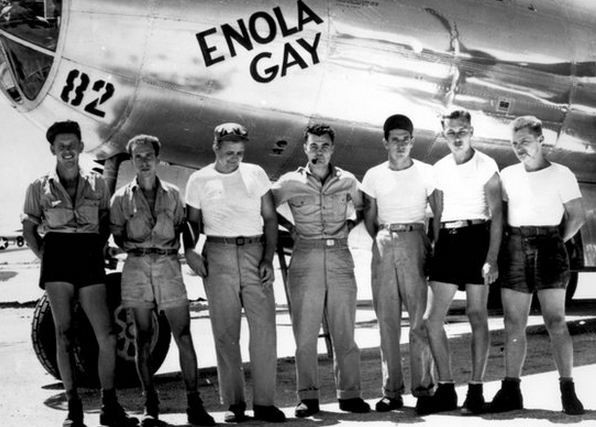Last Surviving Crewman of U.S. B-29 that Dropped the Atomic Bomb on Hiroshima has Died
| Arthur Dominic Villasanta | | Jul 30, 2014 07:59 AM EDT |
(Photo : Wikipedia) The seven-man crew of the B-29 Superfortnress "Enola Gay" stand before their bomber.
Theodore Van Kirk, the navigator who guided the B-29 Superfortress "Enola Gay" to Hiroshima on Aug. 6, 1945, died peacefully at a retirement home in Georgia on July 28. He was 93.
He will be buried next week in Pennsylvania.
"Dutch" Van Kirk was the last surviving member of the seven-man U.S. Army Air Forces crew that dropped the world's first atomic bomb nicknamed "Little Boy" on Hiroshima.
Like Us on Facebook
Over 140,000 Japanese civilians were killed instantly in the massive fireball that obliterated the center of Hiroshima. Thousands of Japanese died years later from radiation sickness.
Van Kirk was 24 when he became navigator of the Enola Gay, which was commanded by Col. Paul Tibbets who died in 2007.
Like his six other buddies, Van Kirk said he had "no regrets" about dropping the 8,900 lb. atomic bomb on Hiroshima. He defended the morality of the bombing, saying it helped to end the Second World War.
The last three surviving members of the crew reunited in 2005, the 60th anniversary of the atomic bombing of Hiroshima.
Tibbets, Van Kirk and Morris Jeppson, the weapon test officer (he died in 2010), issued a joint statement regarding their sentiments about the events of August 6, 1945:
"This year, 2005, marks the sixtieth year since the end of World War II. The summer of 1945 was indeed an anxious one as allied and American forces gathered for the inevitable invasion of the Japanese homeland.
"President Truman made one last demand, one final appeal. Together with Great Britain's Churchill, and Russia's Stalin, the President of the United States urged the Japanese to "proclaim the unconditional surrender of all Japanese armed forces. The alternative," they said, "for Japan is prompt and utter destruction".
"Ignoring the obvious military situation, the Japanese Prime Minister Baron Kantaro Suzuki issued the Japanese refusal to surrender which included these words: "there is no other recourse but to ignore it [the surrender demand] entirely and resolutely fight for the successful conclusion of the war."
"The use of the atomic weapon was a necessary moment in history. We have no regrets
"Enola Gay crew"
From November 1944 to June 1945, the crew of the Enola Gay trained continually for the first atomic bombing mission.
The over six hour flight to Hiroshima began at 02.45 hours, Tinian time, from the island of Tinian in the Marianas. Three B-29s comprised the atomic bombing flight.
Van Kirk's role was to work closely with the bombardier, Tom Ferebee, to confirm the winds and aim point. The bomb dropped from the B-29 at 09:15:17 Tinian time.
U.S. President Harry Truman approved the order to drop the atomic bomb. It was his decision and his hope to avoid an invasion of the Japanese homeland that would have cost tens of thousands of Japanese and allied lives.
©2015 Chinatopix All rights reserved. Do not reproduce without permission
EDITOR'S PICKS
-

Did the Trump administration just announce plans for a trade war with ‘hostile’ China and Russia?
-

US Senate passes Taiwan travel bill slammed by China
-

As Yan Sihong’s family grieves, here are other Chinese students who went missing abroad. Some have never been found
-

Beijing blasts Western critics who ‘smear China’ with the term sharp power
-

China Envoy Seeks to Defuse Tensions With U.S. as a Trade War Brews
-

Singapore's Deputy PM Provides Bitcoin Vote of Confidence Amid China's Blanket Bans
-

China warns investors over risks in overseas virtual currency trading
-

Chinese government most trustworthy: survey
-

Kashima Antlers On Course For Back-To-Back Titles
MOST POPULAR
LATEST NEWS
Zhou Yongkang: China's Former Security Chief Sentenced to Life in Prison

China's former Chief of the Ministry of Public Security, Zhou Yongkang, has been given a life sentence after he was found guilty of abusing his office, bribery and deliberately ... Full Article
TRENDING STORY

China Pork Prices Expected to Stabilize As The Supplies Recover

Elephone P9000 Smartphone is now on Sale on Amazon India

There's a Big Chance Cliffhangers Won't Still Be Resolved When Grey's Anatomy Season 13 Returns

Supreme Court Ruled on Samsung vs Apple Dispute for Patent Infringement

Microsoft Surface Pro 5 Rumors and Release Date: What is the Latest?










